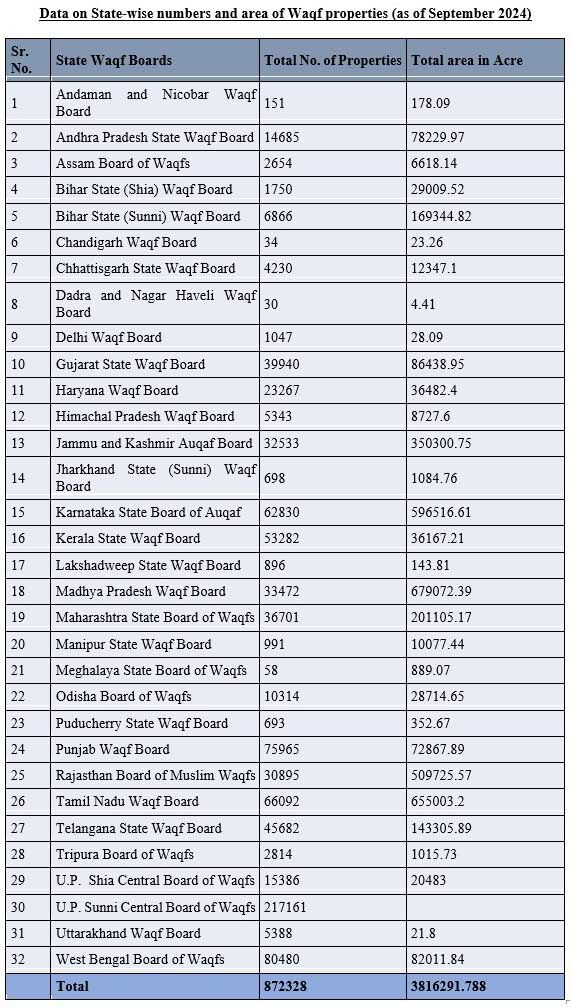Waqf Amendment Bill, 2025: Create A New Chapter in India’s Waqf Legacy
About 8.72 lakh Waqf properties in India, but only 9,279 properties have uploaded ownership documents, of which only 1,083 have Waqf deeds.

Waqf Amendment Bill, 2025: Create A New Chapter in India’s Waqf Legacy
About 8.72 lakh Waqf properties in India, but only 9,279 properties have uploaded ownership documents, of which only 1,083 have Waqf deeds.
India is poised to usher in a transformative era for the management of Waqf properties with the introduction of the Waqf Amendment Bill, 2025. Rooted in a rich historical legacy, Waqf properties—dedicated under Muslim Law for pious, religious, or charitable purposes—hold immense religious, social, and economic significance. The new bill, alongside the Mussalman Wakf (Repeal) Bill, 2024, aims to modernize administration, enhance transparency, and safeguard these assets for future generations.
A Historical Journey of Waqf Regulation in India
The concept of Waqf in India dates back centuries, but its formal regulation began in the early 20th century. The Mussalman Wakf Validating Act of 1913 marked the first step, allowing Muslims to dedicate properties for family welfare and charitable causes. Subsequent laws, including the Mussalman Wakf Act of 1923 and the Wakf Act of 1954, introduced accountability and established administrative bodies like the State Waqf Boards (SWBs) and the Central Waqf Council (CWC).
The Waqf Act of 1995, currently in force, overhauled the system by creating Waqf Tribunals—specialized courts with powers akin to civil courts—and strengthening the roles of the CWC and SWBs. The 2013 Amendment further refined the framework, mandating gender diversity on boards, prohibiting property sales, and extending lease terms to 30 years for better utilization.
Now, the Waqf Amendment Bill, 2025, seeks to address lingering gaps, streamline operations, and align India’s Waqf management with global best practices.

Current Governance Structure of Waqf in India
1. Central Waqf Council (CWC): Advises the Centre and states but doesn’t manage properties directly.
2. State Waqf Boards (SWBs): Primary custodians of Waqf properties within each state.
Waqf Tribunals: Handle Waqf-related disputes, with decisions binding and not challengeable in civil courts.
Key Reforms Proposed in the Waqf Amendment Bill, 2025
The bill promises sweeping reforms:
Modernized Administration: Enhanced digitization and automation of Waqf records to reduce mismanagement and disputes.
Reduced Legal Conflicts: Stronger mechanisms to resolve property disputes efficiently through Waqf Tribunals.
Increased Efficiency: Simplified processes for registering and managing Waqf properties.
Protection of Assets: Stricter safeguards to prevent misuse or illegal transactions.
These changes build on the foundation laid by the 1995 Act and the 2013 Amendment, responding to long-standing calls for reform from stakeholders.
Waqf Properties in India: A Snapshot
According to the Waqf Management System of India (WAMSI) portal, India is home to approximately 8.72 lakh Waqf properties, spanning over 38 lakh acres across 30 states and Union Territories. However, documentation remains a challenge:
4.02 lakh properties are classified as "Waqf by user" (based on traditional use rather than formal deeds).
Only 9,279 properties have uploaded ownership documents, with just 1,083 Waqf deeds digitized.
This gap underscores the urgency of modernization efforts like those proposed in the 2025 bill.
Total Properties: 8.72 lakh
Area Covered: 38 lakh acres
Documented Properties: 9,279
Digitized Waqf Deeds: 1,083
Government Initiatives Supporting Waqf Development
The Ministry of Minority Affairs (MoMA) is driving reforms and infrastructure development via two key schemes:
1. Quami Waqf Board Taraqqiati Scheme (QWBTS): Provides grants-in-aid for digitizing records and deploying manpower. From 2019-20 to 2023-24, Rs 23.87 crore was allocated.
2. Shahari Waqf Sampatti Vikas Yojana (SWSVY): Offers interest-free loans for commercial development of urban Waqf properties, with Rs 7.16 crore spent in the same period.
Funding Allocation (2019-24)
QWBTS: Rs 23.87 crore
SWSVY: Rs 7.16 crore
Why the 2025 Amendment Matters
Waqf properties are more than religious endowments—they are economic assets that can uplift communities when managed effectively. However, issues like poor record-keeping, legal disputes, and mismanagement have long plagued the system. The 2025 bill aims to fix these by leveraging technology and stricter oversight.
“The Waqf Amendment Bill, 2025, is a landmark step toward transparency and efficiency,” says a senior official from the MoMA. “It ensures Waqf properties serve their intended purpose while adapting to modern needs.”
As the Waqf Amendment Bill, 2025, moves toward parliamentary approval, it carries the promise of revitalizing a centuries-old institution. By blending historical reverence with contemporary governance, India is setting a global benchmark for Waqf management. For the millions who rely on these properties—whether for worship, education, or welfare—the reforms signal a brighter, more secure future.
States with largest Waqf holdings
According to available data, Uttar Pradesh (Sunni) holds the highest number of Waqf properties in India, with approximately 2.17 lakh properties, although the total area of these properties has not been disclosed. It is followed by West Bengal, which has around 80,480 properties, and Punjab with 75,965 properties. Tamil Nadu comes next with 66,092 properties, while Karnataka has about 62,830 Waqf properties, making them the top five states with the largest Waqf holdings in terms of property count.




